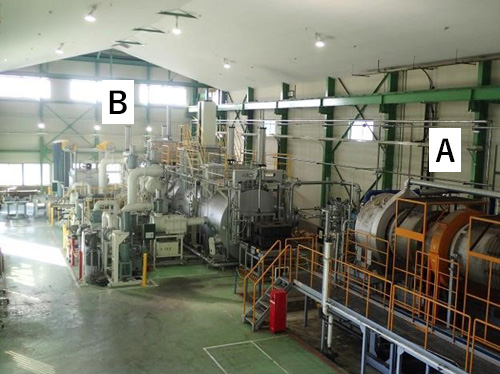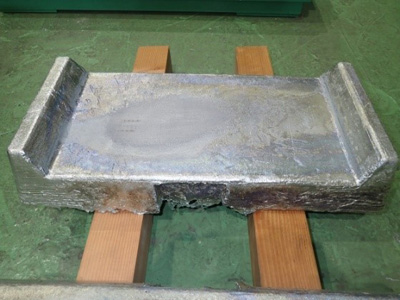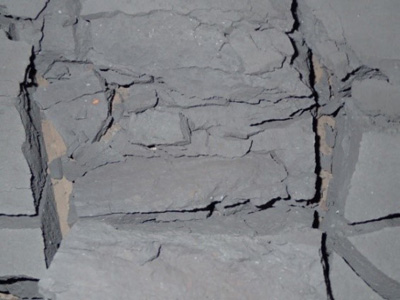JST has announced that a success outcome has been produced under the development subject “Co-Production System for High-Purity Zinc and Raw Material for Steelmaking from Electric Arc Furnace Dust” in the Newly extended TEchnology transfer Program (NexTEP). This development for commercialization had been carried out from March 2014 to March 2019 under consignment to Hoei Metal Co,. Ltd. based on the research results of Dean and Professor Tetsuya Nagasaka, Graduate School of Engineering, Tohoku University and his group.
The electric arc furnace (EAF) dust1 emitted by electric arc furnace melt-shops, which recycle scrap steel, consists of approximately 20% zinc, 30% iron, and small amounts of halogens (chlorine and fluorine) and toxic elements such as lead. Because of this, much of it is disposed of by outsourcing to intermediate processing operators. Conventional methods to recover zinc from EAF dust were energy-consuming and unsuitable for recovering iron.
Hoei Metal Co. developed a processing method for EAF dust using the CaO addition process established by Professor Nagasaka and his group and successfully conducted a demonstration test with a bench-scale plant. First, CaO is added to the EAF dust, which is then heated to remove toxic elements by volatilization. This is subsequently heated in vacuum together with iron, which acts as a reducing agent, to recover zinc and iron as zinc metal and calcium ferrite2, the raw material for steelmaking, respectively. The treatment method to simultaneously recover zinc and iron as each valuable from EAF dust was demonstrated with a mid-sized bench-scale plant with EAF dust treatment capacity of one ton per day. With the CaO addition component, it was confirmed that the refractory zinc ferrite3 contained in the EAF dust can be converted to zinc oxide and calcium ferrite and the halogen and lead removed by optimizing the proportion of CaO added to the EAF dust as well as the processing temperature. Moreover, with the reduction processing component, zinc was separated and recovered in high-purity metallic form by a vacuum heating process using appropriate reducing agents. The residual can be recycled as a new raw material for steelmaking consisting mainly of calcium ferrite. Compared to conventional methods, it is believed that electricity consumption can be reduced by 30%. CO2 emissions can be reduced by 50% because coke or other conventional sources of carbon are not used as the reducing agent for the zinc oxide.
This technology will achieve the combination of treatment that passes through multiple industrial categories into a single process and hopefully contribute to the prevention of global warming.
Notes
1. electric arc furnace (EAF) dust
Fine particulate matter generated by the manufacturing process of steel by remelting scrap steel in an electric arc furnace. The production of one ton of crude steel generates 16-17 kilograms of EAF dust. EAF dust contains zinc because scrap steel includes galvanized steel plate and other scrap containing zinc.
2. Calcium ferrite (2CaO・Fe2O3)
One of the main ferrite phases as raw material for steelmaking. Highly reducible in blast furnace, it is a chemical component necessary for production by adding limestone.
3. Zinc ferrite (ZnO・Fe2O3)
One of the main phases of zinc included in EAF dust. Because of its low reducibility, it is reduced under the Waelz process using charcoal, a powerful reducing agent.
-

Figure 1. Bench scale plant with EAF dust treatment. A. CaO addition part. B. Reduction part.
©Hoei Metal Co. -

Figure 2. Ingot of metallic zinc. This ingot weighs approximately 130 kg. ©Hoei Metal Co.
-

Figure 3. Calcium ferrite produced as raw materials for steelmaking. Calcium ferrite is mainly composed of calcium and iron, contains almost no zinc and lead, halogen.
©Hoei Metal Co.
Program Information
- JST NexTEP
Contact
-
[About Research]
Mizuno Hitoshi
Hoei Metal Co., Ltd
E-mail: mizunohoei-shokai.co.jp
[About Program]
Okishiro Miho
Department of Business Innovation Development, JST
E-mail: jitsuyoka
